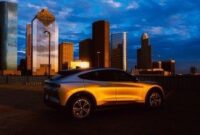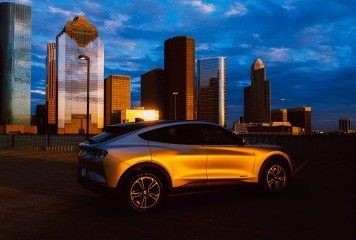2022 TOP 10 BLOG
Environmental and Economic Equity in the Electric Vehicle Revolution
VJEL Staff Editor: Apryl Larkin
Faculty Member: Jenny Carter

For too long environmental justice has collided with energy production and consumption with noxious and devastating results. Energy in the transportation sector is no different. Low-income, indigenous populations, and communities of color live closest to and bear a disproportionate impact from polluting petroleum refineries, freight and bus centers, and high traffic corridors. The impacts of climate change will also hit these communities the hardest, which is caused, in large part, by the transportation sector.
Added all together, a swift transition to electric vehicles and renewable energy can help remedy these inequities while moving the United States closer to its greenhouse gas reduction goals. This must include electrification of multiple modes of transportation, including passenger cars, buses, and light and heavy-duty trucks. This article looks at one part of the transportation equation: the need for equity in making electric vehicles (EVs) more affordable and charging infrastructure more accessible in densely populated urban areas and for lower-income populations.
For the past three years, 2% of vehicles sold in the U.S. were electric. Looking ahead, President Biden’s goals, as identified in his Clean Cars and Trucks Executive Order, the Build Back Better Framework, and the American Jobs Plan, seek to change the equation. The President’s aim for 2030 is for half of all new cars sold to be electric and 500,000 public charging stations installed nationwide. These plans seek to move the ball on environmental justice by dedicating funding for various projects, including cleaning up the transportation sector in disadvantaged communities.
Climate and Public Health Consequences Worst for Disadvantaged and Vulnerable Communities
Switching from conventional gasoline vehicles to electric vehicles can help communities of color and other vulnerable populations by being an important part of global climate change solutions and by directly reducing dangerous air pollution in their communities.
Climate Impacts
In the US, climate change is increasing extreme and deadly heat, floods, droughts, and wildfires. The Congressionally mandated Fourth National Climate Assessment confirms what common sense should tell us: Risks are often highest for those that are already vulnerable, including low-income communities, some communities of color, children, and the elderly. Climate change threatens to exacerbate existing social and economic inequalities that result in higher exposure and sensitivity to extreme weather and climate-related events and other changes.
Global movement to electric vehicles will cause a significant reduction in greenhouse gas emissions and help vulnerable populations. In terms of the U.S.’s contribution, the numbers tell the story. According to the Environmental Protection Agency and the US Department of Energy, the transportation sector is the highest emitter of greenhouse gas emissions at 29% of all emissions; with passenger cars, trucks, SUVs, and minivans contributing more than half of that total. After considering the greenhouse gases emitted when generating the vehicle’s electricity, the average electric vehicle using a nationwide energy mix is responsible for roughly two-thirds fewer emissions than a conventional one.
Air Pollution Impacts
In addition to climate benefits, electric vehicles reduce other air pollutants that cause more immediate and direct health threats to low-income and communities of color. Vehicles are responsible for smog, particulate pollution, volatile organic compounds (VOCs), carbon monoxide, and air toxics such as benzene, formaldehyde, and diesel particulate matter. These pollutants cause or can aggravate serious health problems such as lung damage, asthma, cardiovascular disease, cancer, birth defects and even premature death. In a study of the Northeast and Mid-Atlantic, the Union of Concerned Scientists found communities of color breathe 66% more air pollution from cars, trucks, and buses than white residents.
Affordability – Existing Tax Credits Discriminate Against Low-Income Individuals
For lower-income populations who drive to take part in the EV revolution and to access EV air quality benefits, purchasing an EV must cost no more than a conventional vehicle and there must be ready access to chargers.
Tax Credits vs. Point-of-Sale Rebates Car and charger purchasing incentives will play a critical role in accelerating EV adoption. Current federal incentives have had a limited impact on increasing EV adoption because they are only available to those wealthy enough to take advantage of them and only apply to new vehicles, not used. As often happens with the federal tax code, the tax break has gone to those who need it least and has been withheld from those who need it most.
The Internal Revenue Code provides up to a $1,000 “non-refundable” tax credit for purchasing and installing a residential charger and up to $7,500 “non-refundable” tax credit for purchasing a new EV based on battery size and whether the manufacturer still qualifies for the credit. But, to take full advantage of either credit, you must: (1) have sufficient tax liability, and (2) be financially secure enough to wait until the following year when you file your taxes to get your refund. For example, if you only owe $1,500 in federal taxes the year you bought a new car, your tax credit will only be $1,500, and you cannot carry over the difference to reduce your taxes the following tax year. And, if you purchase a vehicle early in the calendar year, you may have to wait an entire year to receive the credit.
States like New York, Massachusetts, California and Vermont have already adopted EV point of sale rebates. Changing the federal law to allow these rebates for EVs and chargers regardless of tax liability would increase equity in access and eliminate the tax credit waiting game.
New Cars vs. Used
Changing the current law to a point-of-sale rebate will make a big difference for those lucky enough to be in the new car market but still will not help the vast majority of car buyers who purchase used vehicles. The sale of used cars outpaces new car sales by almost 3:1. To be truly equitable and ensure the country transitions as quickly as possible, Congress must adopt a point-of-sale rebate program for used cars as well.
States like California and Vermont are leading the way with programs like California’s Clean Cars 4 All Scrap and Replace Program and Vermont’s MileageSmart. These programs assist lower-income people to trade in old, high-polluting vehicles for low or zero-emission emitting vehicles. California provides up to $9,500 to purchase a new or used EV, and Vermont provides up to $5,000 for used EVs.
Charging Infrastructure Build-Out Must be Convenient and Widely Available
The other side of the electric vehicle coin is ensuring widely available charging infrastructure. It is imperative that charging is easily and equitably accessible so that those living in apartment buildings and rental units can charge just as easily as those with a garage and/or with more financial means to install a charger. There are currently a meager 52,000 public charging stations around 120,000 charging ports in the United States, and they are concentrated primarily on the East and West coasts. President Biden’s American Jobs Plan, announced in March 2021, set the benchmark for 500,000 public electric vehicle chargers by 2030.
Momentum is building. Last month, Congress passed, and the President signed, the $1.2 trillion Infrastructure Investment and Jobs Act. It contains only half of Biden’s $15 billion request for charging infrastructure and electric vehicle public transportation but prioritizes low-and moderate-income neighborhoods to receive grant funding and earmarks on additional $2 billion for disadvantaged communities.
Other positive developments at the state and local levels include cities like Atlanta which requires charging infrastructure as part of the permitting process for new housing and commercial developments; and some utilities, like those in Vermont, are providing discounted or free chargers as part of their GHG emission reduction and demand side management targets, and reduced electric rates for EV charging during off-peak electric demand.
What’s on the Horizon
The first thing to watch will be to see if the Senate can muster the votes needed to pass the Build Back Better Bill, also known as the Budget Reconciliation Bill. It passed the House last month and would increase the maximum incentive for a new EV to $12,500 and turn it into a refundable tax credit that is structured similar to a point-of-sale rebate. It also contains a much smaller, but nonetheless welcome, point-of-sale refund of up to $2,500 for used vehicles. To ensure the incentives are going to those who need them, it places income caps and sales price caps on both new and used incentives. It also includes additional funding for EV charging and educational outreach to underserved communities.
While Congress takes the first critical steps to address the climate and equity challenge no experts expect the Infrastructure Act and the Build Back Better Bill, if passed, to get us to the EV finish line. But it is highly unlikely Congress will do any more in the near term.
In the meantime, keep an eye on state and local government and utility efforts. Because most of the funding from these bills will be distributed to states, it is these entities that will be largely determining how effectively the dollars will be spent and whether they achieve the objective of making progress toward closing the environmental and economic equity gaps.

